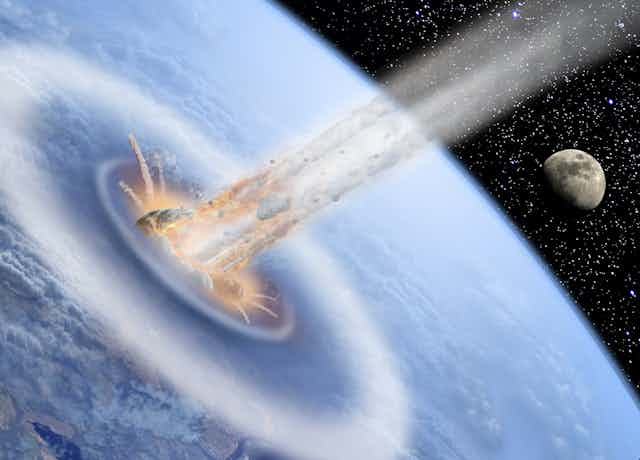A team of scientists recently set off to drill a 1,500m-deep hole into the seabed off the coast of Mexico. Their goal is to learn more about the asteroid impact some 66m years ago that many scientists believe killed the dinosaurs. But how do we know that this now-invisible crater, measuring some 180km across, is responsible for such devastation to life across the globe?
In one of the greatest titled books ever, T. rex and the Crater of Doom, Walter Alvarez told the story of how he and his nobel prize-winning physicist father Luis revolutionised our understanding of the end of the dinosaurs. We now think that rather than just suffering a long decline caused by natural climate change, dinosaurs and many other species of the time effectively disappeared overnight following a massive asteroid impact.

This theory has changed remarkably little since the Alvarezes first published their theory in 1980. Walter had been studying sedimentary rocks that were laid down at the time of the dinosaurs’ extinction, known as the Cretaceous-Paleogene boundary because they represent a change from one geological period to another. He discovered that the boundary layer in rocks found at Gubbio in Italy contained ten times the normal levels of the metal iridium.
Iridium is thought to have arrived on the surface of the Earth in tiny quantities from showers of meteorites. Luis had the insight that such a high concentration of the metal in one layer of rock meant it must have arrived in one huge asteroid impact. The team then confirmed another iridium spike in a Cretaceous-Paleogene boundary rock section at Stevns Klint in Denmark.
They reasoned that the spikes implied there had been an asteroid impact so big that it threw enough dust (including tiny particles of iridium) into the atmosphere to black out the sun around the globe. This would have prevented plants from photosynthesising and, as was later suggested, caused global freezing for a short time, leading to the mass extinction of many species. They worked out that such an asteroid would have weighed at least 34 billion tonnes and measured around 7km in diameter, producing a crater around 100–200km across.

Geologists in uproar
Without evidence for such a crater, and with a seemingly simple calculation from only two iridium spikes, most geologists in 1980 were in uproar. They claimed that Luis Alvarez was trying to hoodwink them with some rather wild and speculative ideas. However, throughout the 1980s, dozens of identical iridium spikes were found at all investigated Cretaceous-Paleogene boundary sections around the world. Geologists also discovered other physical indicators of a large asteroid impact, such as pressure-shocked minerals and rocks that had been melted but whose chemistry meant they didn’t come from magma.
Then in 1991, Canadian PhD student Alan Hildebrand tracked down the Chicxulub crater in the Yucatán peninsula in southern Mexico. At 180–200km in diameter and 20km in depth, the crater was the right size to match the Alvarez hypothesis.

Hildebrand was led to the site of the impact by effectively following the debris it threw into the air back to its source. Locations further from the crater would have been covered in less dust as it spread out across the planet. Hildebrand noticed that the Italian and Danish boundary layers investigated by Alvarez were only 1cm thick, whereas those in Texas and Caribbean islands such as Haiti were more like a metre thick.
However, it still took a while to locate the Chicxulub crater because it had been completely covered by sediments deposited in the previous 66m years. And while half of it lies under dense tropical rainforest, the other half is beneath the Caribbean seabed. Hildebrand used evidence from boreholes made by Mexican oil company Pemex in the 1960s to prove the crater’s existence. Subsequent geophysical surveys that can scan below the surface have established the exact size and shape of the structure, which is roughly circular with three concentric rings, as you would expect from a massive impact.
Studying the crater
After the asteroid hit the Earth and penetrated deep into the crust, it would have vaporised, with the back-blast raising the surrounding crust several kilometres above its normal level. Within seconds, as the debris and dust spread outwards at high speed, the crust would have collapsed back, and multiple inner and outer rings of faulted crust would have formed around the centre of the impact.
Further geophysical surveys will help us understand the structure in more detail and test whether the detailed model for back-blast, collapse, and sediment fall-back is correct. The research team currently studying the seabed portion of the crater hope to learn which part of the crust it comes from, so we can better understand how it was formed and how much debris was sent into the atmosphere.
The model that links impact with extinction has not changed much since its first formulation in 1980. But scientists are still debating how important the event was. Some analysts are happy to accept that the impact and its consequences were the sole driver of extinction. Others accept it had a role, but also draw attention to the long-term decline of some groups that had already begun before the asteroid hit and the significant volcanic eruptions from the Deccan Traps in India. Despite this important debate, the Chicxulub crater remains the smoking gun responsible for the rapid disappearance of the dinosaurs and so many other animals and plants 66m years ago.

